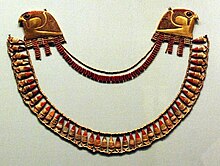Menhet, Menwi and Merti
| colspan="2" valign="top" style="background:Portal:Ägyptologie/Farbe1;" | Menhet, Menwi and Merti in hieroglyphs | |||||||
|---|---|---|---|---|---|---|---|
Menhet | |||||||
Menwi | |||||||
Merti | |||||||
| colspan="2" valign="top" style="background-color:Portal:Ägyptologie/Farbe3" | | |||||||
colspan="2" style="text-align:center; font-size:smaller; vertical-align:top; background-color:Portal:Ägyptologie/Farbe3;" |  | |||||||
Menhet, Menwi and Merti were three minor foreign-born wives of pharaoh Thutmose III who were buried in a lavishly furnished rock-cut tomb in Wady Gabbanat el-Qurud. Two of their names are West-Semitic in origin though none are Hurrian.[2] Each were given the title of King's Wife, and were likely only minor members of the royal harem.[3] It is not known if the women were even related since the faces on the lids of their canopic jars are all different.[4]
The tomb of Thutmose III's foreign wives[edit]

Their tomb was originally discovered in August 1916 in the desert mountain cliffs in the southwest valley near Luxor and promptly looted by Qurnawi villagers.[5] When the Egyptian antiquities authorities tracked down the burial in September of that year, all that was left at the original site were the objects discarded by the tomb robbers. It is thought that originally there were three intact burials at the site. Only the gold and stone objects had survived as the wood and the mummies and wooden materials had disintegrated due to moisture "from water seeping through the cliffs above."[6] However, most of their surviving funerary remains were tracked down and purchased on the antiquities market at the time and many now reside at the Metropolitan Museum in New York.[7]
Some of the treasures found within their tomb include gold diadems, gilded gold, toe and feet sandals, gold, carnelian and glass bracelets together with other vessels. Each of their bracelets are inscribed with the cartouche of Thutmose III. Other objects found in the tomb include Hathor decorated gold, silver and glass mirrors. While the collection is impressive, none of their headdresses employed the vulture motif used by more senior queens.[8]
Like the cliff tomb of Hatshepsut that Howard Carter found in Wady A, the tomb of Thutmose's foreign wives was also cut into a crevice.[9] Its entrance, though, "was cut into a platform about 10 metres from the wady floor, quite like Thutmosis III's tomb in the Valley of the Kings."[10] Menhet, Menwi and Merti's tomb consisted "of a single undecorated chamber--ca. 5 X 7.5 metres, by 1.5 to more than 2 metres high."[11]
Gallery[edit]
-
Wig cover, an approximate recreation (from original pieces). Made of gold, gesso, carnelian, glass and jasper.
-
Sheet gold finger and toe coverings, plus sandals, on display at the Metropolitan Museum of Art.
-
Sheet gold pectoral and other coverings.
References[edit]
- ^ a b c J. Tyldesley, Chronicle of the Queens of Egypt, 2006, Thames & Hudson
- ^ Christine Lilyquist, The Tomb of Thutmosis III's foreign wives: A survey of Architectural Type, Contents and Foreign Connections in Proceedings of the Seventh International Congress of Egyptologists, Cambridge 3-4 September 1995; ed. C.J. Eyre, Uitgeberij Peeters, Leuven, 1998. pp.679-680
- ^ Buzby, Russell, "Imperialism in Early New Kingdom Egypt", Kaleidoscope Eyes, p.16 October 2002 http://www.sydgram.nsw.edu.au/CollegeSt/extension/Oct02/Buzby.pdf
- ^ Lilyquist, Proceedings, p.679
- ^ Lilyquist, Proceedings, p.677
- ^ Lilyquist, Proceedings, p.678
- ^ Tyldesley, Joyce. Chronicle of the Queens of Egypt. p.111. Thames & Hudson. 2006. ISBN 0-500-05145-3
- ^ Buzby, Russell, "Imperialism in Early New Kingdom Egypt", Kaleidoscope Eyes, p.16 October 2002 http://www.sydgram.nsw.edu.au/CollegeSt/extension/Oct02/Buzby.pdf
- ^ H.E. Winlock, The Treasure of Three Egyptian Princesses, Publication of the Metropolitan Museum of Art Department of Egyptian Art, 10 (New York, 1948), pl.1
- ^ Lilyquist, Proceedings, p.678
- ^ Lilyquist, Proceedings, p.678
Literature[edit]
- Aidan Dodson & Dyan Hilton, The Complete Royal Families of Ancient Egypt, Thames & Hudson, 2004, ISBN 0-500-05128-3, pp. 138-139
- Christine Lilyquist, The Tomb of Tuthmosis III's Foreign Wives, New York 2004 ISBN 030010121X



